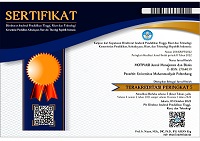Pengaruh Karakteristik Demografi terhadap Literasi Keuangan Masyarakat Kota Bengkulu
Abstract
ABSTRACT
Purpose - This study aims to examine how the demographic characteristics of the variable influence on financial literacy.
Design/methodology - The method used in this research is descriptive and verification methods.
Findings – The result show that A wide variety of characteristics of the respondents used to describe the level of financial literacy Bengkulu City community. High and low levels of financial literacy (financial knowledge) is determined by the relationship or interaction between the characteristics of age, gender, income level, marital status, and financial experience. Age is a variable very high influence low level of financial knowledge (financial knowledge). Variations in the rate of age will cause variations in the level of financial knowledge. The higher level of the person's age the higher the level of knowledge about finances.Keywords
Full Text:
PDFReferences
Agnew, S., & Harrison, N. (2015). Financial literacy and student attitudes to debt: Across national study examining the influence ofgender on personal finance concepts. Journal of Retailing and Consumer Services, 122-129.
Almenberg, J., & Soderbergh, J. S. (2011). Financial Literacy and Retirement Planning in Sweden. Journal Of Pension Economics and Finance, 10, pp. 585-598 doi:10.1017/S1474747211000497585-598.
Atkinson, A., & Messy, F. A. (2011). Assessing FInancial literacy in 12 countries: an OECD/INFE international pilot exercise. Journal of Pension Economics and Finance,10, pp .657-665 doi:10.1017/S1474747211000539.
Atkinson, A. and F. Messy (2012), “Measuring Financial Literacy: Results of the OECD / International Network on Financial Education (INFE) Pilot Study”, OECD Working Papers on Finance, Insurance and Private Pensions, No. 15, OECD Publishing. http://dx.doi.org/10.1787/5k9csfs90fr4-en
Bowen, C. F. (2002). Financial Knowledge Of Teens And Their Parents. Association for Financial Counseling and Planning Education, https://afcpe.org/assets/pdf/vol1328.pdf.
Brown, M., & Graf, R. (2013). Financial Literacy and Retirement Planning in Switzerland. Numeracy.Numeracy: Vol. 6: Iss. 2, Article6.
Chen, H., & Volpe, R. P. (1998). An Analysis of Personal Financial Literacy Among College Students. Financial Servives Review, Vol.7, No.2, pp. 107-128.
Chieffe, N., & Rakes, G. K. (1999). An integrated model for financial planning. Financial Services Review, 261–268.
Eagly, A., & Chaiken., S. (1995). The psychology of attitudes. Psychology & Marketing, 459–466.
Grohmann, A., Kouwenberg, R., & Menkhoff, L. (2015). Childhood roots of financial Literacy. Journal of Economic Psychology, 114-133.
Hung, A. A., Parker, A. M., & Yoong, J. (2009). Defining and Measuring Financial Literacy. RAND working papers series , https://www.rand.org/.../rand/pubs/working_papers/2009/RAND_WR708.p...
Kapoor, J., Dlabay, L., & Hughes, R. J. (2012). Personal Finance.Tenth edition.New York: Mc Graw-Hill.
Kajian Ekonomi Dan Keuangan Regional Provinsi Bengkulu. (2015). www.bi.go.id
Khrisna, A., Sari, M., & Rofaida, R. (2010). Analisis Tingkat Literasi Keuangan di Kalangan Mahasiswa dan Faktor-Faktor yang Mempengaruhinya, www.academia.edu/.../Analisis_tingkat_literasi_keuan...
Sohn, S.-H., et al.(2012). Adolescents’ ?nancial literacy: The role of ?nancial socialization agents,?nancial experiences, and money attitudes in shaping ?nancial literacy among South Korean youth. Journal of Adolescence doi:10.1016/j.adolescence.2012.02.002
Lisbon. (2011). Survey On The Financial Literacy Of The Portuguese Population. Portugal : Banco De Portugal, http://www.clientebancario.bportugal.pt/.
Lusardi, A. (2008a). Household Saving Behavior: The Role of Financial Literacy, Information, and Financial Education Programs. NBER Working Paper No. 13824, http://www.nber.org/papers/w13824.pdf.
Lusardi, A., & Mitchell, O. S. (2008b). Planning and Financial Literacy: How Do WomenFare? . NBER Working Paper No.13750, http://www.nber.org/papers/w13750.pdf
Lusardi, A., & Mitchell, O. S. (2011). Financial literacy around the world: an overview. Journal of Pension Economics and finance, 10, pp. 497-508, doi:10.1017/
Lusardi, A., & Tufano, P. (2015). Debt literacy, financial experiences, and overindebtedness. Journal of Pension Economics and Finance,Vol. 14,No. 04, pp. 332 - 368.
Mandell, L. (2006). Financial Literacy: If It’s So Important, Why Isn’t It Improving? Networks Financial Institute, ssrn.com/abstract=923557
Mandell, L.( 2008). The Financial Literacy of Young American Adults" Results of the 2008 National Jumpstart Coalition Survey of High School Seniors and College Students", Washington, The Jumpstart Coalition for Personal Financial Literacy
Manurung, P. D. (2012). Teori Investasi: Konsep dan Empiris.”. Jakarta: PT Adler Manurung Press.
Moore, D. L. (2003). Survey of financial literasy in washington state : knowledge, attitude, behavior and experiences. Social and Economic Sciences Research Center,https://www.researchgate.net
Mouna, A., & Jarboui, A. (2015). Financial Literacy and portofolio diversification : an observation from the Tunisia stockmarket. Jounal of Bank Marketing, 808-822.
Mastercard Financial Literacy Index Report (2014h1), http://www1.mastercard.com/content/intelligence/en/research/reports/2015/mastercard-financial-literacy-index-report-2014h1.html
Nachrowi, N. D., & Usman, H. (2008). Penggunaan Teknik Ekonometri . Jakarta: Rajawali Press.
Navickas, M., Gudaitis, T., & Krajnakova, E. (2014). Influence of Financial Literacy on Management of Personal Finances in a Young Household. Business: Theory and Practice, 32–40, http://www.btp.vgtu.lt/
Nidar, S. R., & Bestari, S. (2012). Personal Financial Literacy Among University Students Case Study at Padjadjaran University Students, Bandung,Indonesia. World Journal of Social Sciences, Vol. 2, No. 4, pp. 162 – 171.
Nyamute, W., & Maina, J. M. (2010). Effect of Financial Literacy on Personal Financial Management Practices, http://erepository.uonbi.ac.ke:8080/handle/11295/5721.
Peng, T.-C. M., Bartholomae, S., Fox, J. J., & Cravener, G. (2007). The Impact of Personal Finance Education Delivered in High School and College Courses.J Fam Econ Iss ,Vol.28, pp. 265–284, DOI 10.1007/s10834-007-9058-7
Pankow, Debra. (2003). Financial Values,Attitudes and Goals. North Dakota State University,http://library.ndsu.edu/
R.Anthony, R. A. (2011). Knowledge, Attitude, Practice, and Satisfaction on Personal Financial Management Among Medical Practitioners In the Public and Private Medical Servces In Malaysia. Thesis Submitted In Fulfilment For The Degree Of Master Of Medical Science.
Sabri, M. F., Cook, C. C., & Gudmunson, C. G. (2012). Financial well-being of Malaysian college students. Asian Education and Development, Vol. 1, No. 2, pp. 153-170153-170.
Sekita, S. (2011). Financial Literacy and Retirement Planning in Japan. Journal of Pension Economics and Finance, Vol. 10, pp. 637-656 , doi:10.1017/S1474747211000527.
Sohn, S.-H., Joo, S.-H., Grable, J. E., Lee, S., & Kim, M. (2012). Adolescents’ financial literacy: The role of financial socializationagents, financial experiences, and money attitudes in shapingfinancial literacy among South Korean youth. Journal of Adolescence,35, pp. 969-980.
Tamimi, H. A., & Kalli, A. A. (2015). Financial Literacy and Investment decision of UAE investors. The Journal of Risk Finance, Vol. 10 ,Iss. 5, pp. 500 - 516.
Worthington, AC. (2006). Predicting Financial Literacy in Australia, Financial Services Review,Vol. 15, No.1, pp.59-79.
DOI: https://doi.org/10.32502/mti.v2i2.2048
Refbacks
- There are currently no refbacks.
Copyright (c) 2019 MOTIVASI Jurnal Manajemen dan Bisnis
Motivasi: Jurnal Manajemen dan Bisnis is Published by Management Department, Economic and Business Faculty, Muhammadiyah University of Palembang. This work is licensed under a Creative Commons Attribution-ShareAlike 4.0 International License.
Indexed/Abstracted






.png)
.png)



